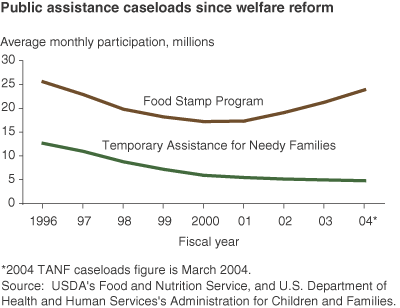Former Welfare Recipients Affect Economic Growth and Wages
- by Kenneth Hanson and Karen Hamrick
- 4/1/2005
As Congress considers reauthorization of the Personal Responsibility and Work Opportunity Reconciliation Act of 1996, a primary focus remains on moving public assistance recipients who are not working into jobs. During 1996-2000, a period of strong economic growth, an estimated 2.4 million new workers moved from public assistance to primarily low-skill jobs, representing 18 percent of employment growth during that time. Temporary Assistance for Needy Families (TANF) caseloads fell by 50 percent, from 12.6 million recipients to 5.9 million. Food stamp caseloads fell by 30 percent from 25.5 million recipients to 17.2 million. Since the recession in 2001, hiring has been slow to recover, with substantial job growth starting in 2004. Food stamp caseloads began increasing in 2001 and have continued to increase through 2004 in response to economic conditions and expanded efforts to enroll eligible nonparticipants into the program. However, TANF caseloads have continued to fall, although at a slower rate in 2003 and into 2004. Looking back at labor market changes during the years following the 1996 welfare reform may inform current policy discussions. ERS research examined the effects of the movement of public assistance recipients into the labor force in the late 1990s, when the growing U.S. economy generated many new jobs—particularly jobs in low-skill occupations.
New workers from public assistance programs accounted for 1 percentage point of real gross domestic product (GDP) growth during 1996-2000. Simultaneously, the large influx of former welfare recipients into the labor force affected the wages and employment opportunities of other low-skill workers. The reduction in wage growth was estimated to be 2.5 percentage points for low-skill workers. Wage growth was estimated to be 4.4 percent versus 6.9 percent without the influx of former welfare recipients. So, the actual wages of low-skill workers already in the workforce increased, but the increase was not as much as it would have been without the influx of new workers.
This article is drawn from:
- Hanson, K. & Hamrick, K. (2004). Moving Public Assistance Recipients Into the Labor Force, 1996-2000. U.S. Department of Agriculture, Economic Research Service. FANRR-40.


